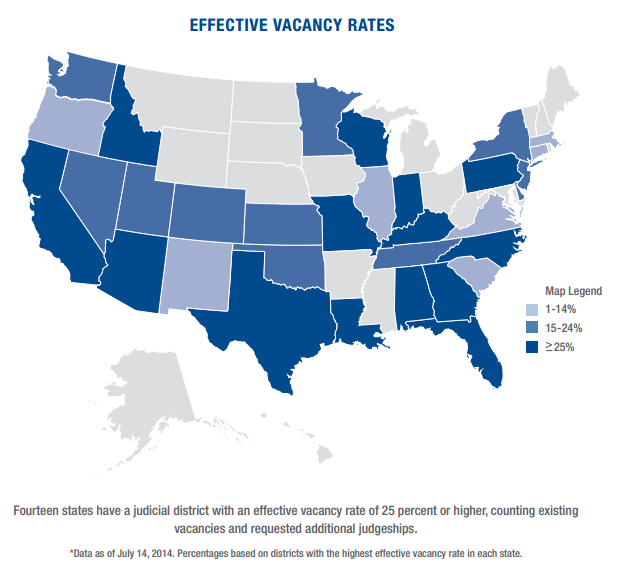Since 2009, federal trial courts have experienced unusually high and sustained levels of judicial vacancies. Following years of obstruction, the pace of Senate confirmation of judicial nominees has dramatically accelerated since April 2014. Yet a vacancy backlog continues, including high levels of judicial vacancies without nominees.
The Brennan Center first examined the growing number of federal district court vacancies in a July 2013 report, finding that these vacancies have burdened federal judges with unworkable caseloads. Additional studies were completed in November 2013 and February 2014.
Our most recent analysis, published in July 2014, featured interviews with trial court judges, court administrators, and practitioners who documented the harmful impact of high vacancy levels on the administration of justice, including case delays and reduced time for judges to spend on individual cases.
Without continued attention by the President and Senate, many federal judgeships are likely to remain unfilled for the foreseeable future. The White House and Senate should prioritize identifying nominees for unfilled judgeships and continue their recent progress in confirming qualified nominees.
Below is a chart of all federal judicial court vacancies followed by a breakdown of district court vacancies.
All Federal Judicial Vacancies
*As reported by the Administrative Office of the U.S. Courts
Federal District Court Vacancies
While most attention to federal judicial vacancies has focused on the appellate courts, our district courts have also experienced high levels of vacant judgeships. District courts are the workhorses of the federal judicial system, resolving legal disputes, conducting civil and criminal trials, and overseeing cases from filing to termination.
In our most recent analysis, the Brennan Center examined 10 districts that currently have judicial vacancies or that recently had vacancies filled. Interviews with 20 chief judges, court administrators, and practitioners suggest that vacancies affect the ability of many courts to effectively and timely administer justice.
The interviewees reported four major impacts:
- Case delays: Delay in resolving motions and hearing trials was the most common impact cited in interviews with judges and court administrators, with eight districts reporting delays caused by vacancies. Our analysis of court data found that having a single judicial vacancy for 12 months was associated, at a statistically significant level, with a two percentage point increase in the percentage of cases pending for three years or more.
“We don’t neglect the seventh amendment, the right to a civil trial. But we tell people, if this is what you want to do, it will take time to get there.”
— Chief Judge William Skretny, Western District of New York
- Less time spent on individual cases: Judges in four districts observed that heavier caseloads due to vacancies meant they spent less time considering individual cases, raising troubling concerns about the quality of justice dispensed.
“Sometimes you’d like to be able to spend more time thinking and writing, or having more hearings. We just don’t have time to do that.”
— Chief Judge Anne Conway, Middle District of Florida
- Administrative burdens: Vacancies mean more than the loss of a judge. Judges and court administrators in five districts emphasized the “trickle-down” effect on judicial administration, including the loss of law clerks and other administrative resources and reduced capacity for the work of judicial committees.
“It’s a trickle-down effect. When you have a vacancy it affects all parts of your court system.”
— Chief Judge Leonard Davis, Eastern District of Texas
- Risk of judicial burn-out: Vacancies mean more work for a district’s remaining judges. In eight districts, chief judges and court administrators raised concerns about judges taking on heavy workloads in an effort to compensate for vacancies, with four specifically citing judicial burn-out as a cause for concern.
“It’s like an emergency room in a hospital. The judges are used to it and people come in and out and get good treatment. But the question is, can you sustain it? Eventually you burn out.”
— Chief Judge Federico Moreno, Southern District of Florida
The Need for New Judgeships
Congress has not passed a comprehensive judgeship act since 1990, and the last time that any district court judgeships were created by Congress was in 2002. Nationwide, 32 out of 94 districts have been recommended for additional judgeships by the Judicial Conference of the United States, based on the districts’ workload and self-assessment of need. When these recommended additional judgeships are added to the number of existing vacancies, districts’ “effective vacancy rates” are striking, with 20 districts in 14 states left with vacancy rates of 25 percent or higher, as of July 14, 2014.

Additional Resources
- The Administrative Office of the U.S. Courts tracks current vacancies, future vacancies, confirmation dates, judicial emergencies, and more.
- Alliance for Justice provides information on pending nominees, vacancies without nominees, and upcoming Senate actions, in addition to reports on individual nominees.
- The American Constitution Society published a report in 2013 on the dysfunctional federal judicial nominations process. The Society also maintains a website called judicialnominations.org with a map of current vacancies, nomination statistics, and relevant news articles.
- The American Judicature Society lists detailed information about federal judicial nominating commissions.
- Russell Wheeler of the Brookings Institution published a report in 2013 comparing the nominations processes of the Obama, Bush, and Clinton administrations.
- Justice at Stake lists a number of nominating advisory commission resources, in addition to judicial nominations news.
- Judging the Environment approaches the federal judicial nominations process from an environmental protection perspective.